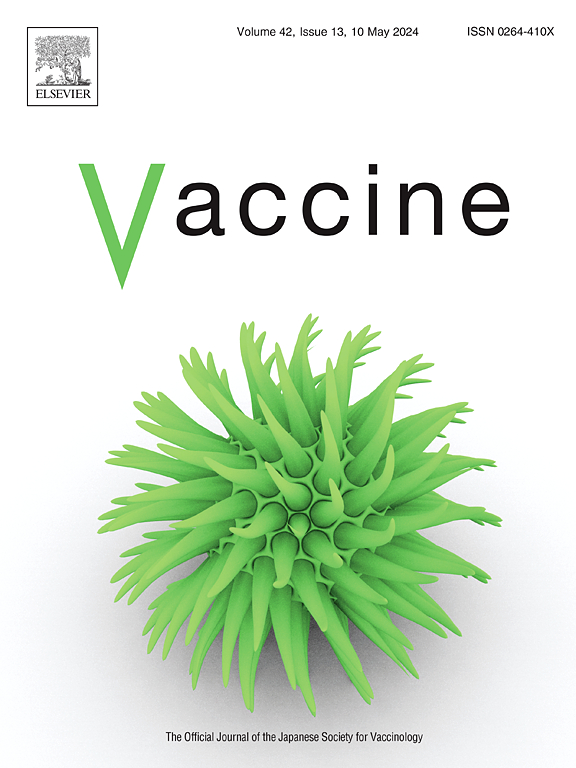阿肯色州在COVID-19大流行前后对常规儿童疫苗接种的犹豫。
IF 4.5
3区 医学
Q2 IMMUNOLOGY
引用次数: 0
摘要
目的:在COVID-19大流行之前,疫苗可预防疾病在全国范围内增加,这与儿童疫苗接种覆盖率低有关。美国南部各州对父母疫苗犹豫的研究有限,自2020年初以来,儿童疫苗接种率有所下降。我们的研究目的是检查阿肯色州居民在COVID-19大流行前后父母对疫苗的犹豫。方法:采用重复横断面设计,于2019年(n = 407)和2023年(n = 402)对阿肯色州≤6岁儿童的父母监护人进行电话调查。评估了父母对常规儿童疫苗的犹豫和疫苗信心。加权多元逻辑回归模型检验了社会人口因素与父母犹豫之间的关系。结果:从2019年到2023年,父母犹豫率上升了15个百分点(35.7%[38.6% ~ 43.0%]至50.3%[40.7% ~ 60.0%]),无犹豫率下降(64.3%[56.7% ~ 71.0%]至49.7%[40.2% ~ 59.0%])。父母年龄与疫苗犹豫之间的关系因地区而异,西南地区(东北和西北地区也是如此)年龄较大的父母比中部地区表现出更大的犹豫(OR为1.21[1.07-1.35])。与公立学校孩子的父母相比,私立学校孩子(OR 2.60[1.22-5.51])或在家上学孩子(OR 2.65[1.24-5.67])的父母有更高的犹豫几率。结论:尽管年应答率较低,但研究结果表明,在阿肯色州COVID-19大流行后,父母对疫苗的犹豫有所增加。在我国大部分农村人口中,疫苗犹豫仍然是一个令人关切的问题。需要使用类似的调查工具进行重复分析,以了解这些趋势是否在阿肯色州人口或类似的南部农村人口中保持不变。本文章由计算机程序翻译,如有差异,请以英文原文为准。
Hesitancy towards routine childhood vaccinations before and after the COVID-19 pandemic in Arkansas
Objective
Prior to the COVID-19 pandemic, vaccine-preventable diseases increased nationally, associated with low childhood vaccination coverage. Studies on parental vaccine hesitancy in southern U.S. states is limited, and childhood vaccine uptake has decreased since early 2020. Our study purpose was to examine parental vaccine hesitancy before and after the COVID-19 pandemic among Arkansas residents.
Methods
A repeated cross-sectional design using telephone surveys was conducted among Arkansas parental guardians of children aged ≤6 years in 2019 (n = 407) and 2023 (n = 402). Parental hesitancy towards routine childhood vaccines and vaccine confidence was assessed. Weighted multiple logistic regression models examined associations between sociodemographic factors and parental hesitancy.
Results
Parental hesitancy increased 15-percentage points from 2019 to 2023 (35.7 % [38.6% – 43.0 %] to 50.3 % [40.7 % - 60.0 %]), while those expressing no hesitancy declined (64.3 % [56.7 % - 71.0 %] to 49.7 % [40.2 % - 59.0 %]). The association between parental age and vaccine hesitancy differed by region, with older parents in the Southwest region (and similarly in the Northeast and Northwest) showing greater hesitancy compared to those in the Central region (OR 1.21 [1.07–1.35]). Compared to parents of public-school children, those with privately schooled (OR 2.60 [1.22–5.51]) or homeschooled children (OR 2.65 [1.24–5.67]) had higher odds of hesitancy.
Conclusions
Despite low annual response rates, findings suggest an increase in parental vaccine hesitancy following the COVID-19 pandemic in Arkansas. Vaccine hesitancy remains a concern in our largely rural population. Repeat analyses with similar survey tools is needed to understand if these trends are maintained in the Arkansas population or similar southern rural populations.
求助全文
通过发布文献求助,成功后即可免费获取论文全文。
去求助
来源期刊

Vaccine
医学-免疫学
CiteScore
8.70
自引率
5.50%
发文量
992
审稿时长
131 days
期刊介绍:
Vaccine is unique in publishing the highest quality science across all disciplines relevant to the field of vaccinology - all original article submissions across basic and clinical research, vaccine manufacturing, history, public policy, behavioral science and ethics, social sciences, safety, and many other related areas are welcomed. The submission categories as given in the Guide for Authors indicate where we receive the most papers. Papers outside these major areas are also welcome and authors are encouraged to contact us with specific questions.
 求助内容:
求助内容: 应助结果提醒方式:
应助结果提醒方式:


